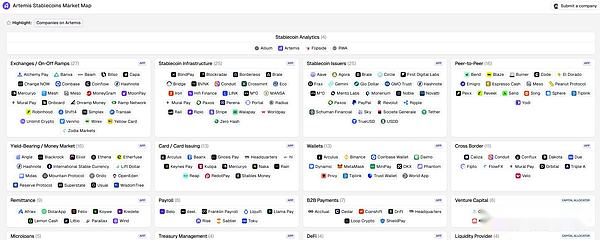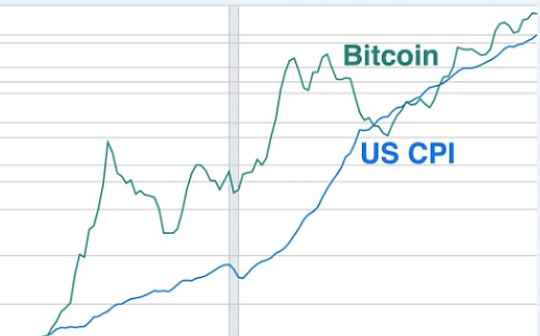
Author: Rob Hadick, partner of Dragonfly; compiled by: 0xjs@Bitchain Vision
I’ve received a lot of questions about where the stablecoin market is going and what parts will generate the greatest value, so I’m sharing some unfiltered ideas here.
Specifically, I look at the market in several ways—more than most frameworks I’ve seen (although not as complex as very good ones. Artemis Market Map).
 Because payment is inherently complex and subtle.It is very important to know who is doing what and owning, especially investors who seem to often ignore nuances.
Because payment is inherently complex and subtle.It is very important to know who is doing what and owning, especially investors who seem to often ignore nuances.
These categories are: (1) settlement channel, (2) stablecoin issuer, (3) liquidity provider, (4) value transfer/monetary services, (5) aggregation API/message delivery, (6) merchant gateway,and (7) stablecoin-driven applications.
You might ask: Why are there so many categories, especially I don’t even cover core infrastructure like wallets or third-party compliance.This is because each field has its own defensive “moat” and different ways to obtain value.Of course, there is overlap between providers, but it is crucial to understand the difference between each part of the stack.
Here is my opinion:
1. Settlement channel:
This is all about network effects—think deep liquidity, low fees, fast checkout times, reliable uptime, and inherent compliance and privacy.They are likely to form a winner-takes-all market.I am very skeptical whether the general blockchain can meet the scale and standards of the major payment network.I expect the general chain extension or layer 2 to work, but the point is that we need solutions that are built specifically.The winners here will be very valuable and will likely focus on stablecoins/payments.
2. Stablecoin issuer:
Currently, issuers (such as Circle and Tether) are clearly winners because they benefit from huge network effects and high interest rates.But looking forward, they will be in trouble if they continue to act like asset managers rather than payment companies.They require investment in fast, reliable infrastructure, high compliance standards, cheap minting/redemption processes, integration of central and core banks, and overall improvements in liquidity (like what @withAUSD is doing).”Stablecoin-as-a-service” platforms (such as Paxos) will give birth to countless competitors, but I still believe that neutral non-bank and fintech stablecoins will win a big victory because the competitive situation does not allow closed systems to be in no credible neutralThe third party intervenes in case of transactions (and benefits others).Issuers already have a lot of value and some will continue to win big, but they need to develop rather than just issue.
3. Liquidity Provider (LP):
These are often OTC counters or exchanges these days, which are either large, successful cryptocurrency businesses or smaller businesses that cannot compete well on a wide range of cryptocurrency capabilities and have turned to focusin stablecoin business.This field feels extremely commoditized, with very little pricing power – the moat revolves around getting cheap money, uptime and deep liquidity/large amounts of currency pairs.This means that over time, big companies should dominate providers focused on stablecoins.I don’t think that a stablecoin-focused LP can create a powerful and lasting advantage.
4. Value transfer/monetary service (stablecoin’s “PSP”):
Sometimes called “stablecoin aggregation” platforms, such as @stablecoin and @conduitpay, these companies win and build moats when they have proprietary tracks and have direct relationships with banks rather than using third-party providers.Their “moat” comes from bank relations and capabilities, flexibility in handling different forms of payments, global reach, liquidity, uptime and top-level compliance.Many say they do this, but few actually have their own truly proprietary infrastructure.Winners here will enjoy moderate pricing power, form regional duopoly or oligopoly, and complement traditional PSPs to become very large businesses.
5. Aggregation API/Message Platform:
These participants often say that they do the same thing as PSP, but they just wrap or aggregate the API.They themselves do not assume compliance or operational risks – they should be seen as a market for PSPs and LPs.They can now charge high fees, but eventually they get squeezed (perhaps completely de-mediated) because they don’t handle the “hard” part of the payment process or infrastructure construction.They call themselves “Plaid for stablecoins” and forget that blockchain has solved many of the original pain points Plaid has solved for traditional banks/payments.Unless they are closer to the end customer and take on more stacks, they will have a hard time sustaining profits and business.
6. Merchant gateway/entry channel:
These help merchants and businesses accept stablecoins or cryptocurrencies.They sometimes overlap with PSP, but mainly provide simple development tools, while aggregating third-party compliance and payment infrastructure and packaging them into a user-friendly interface.They want to win like Stripe – in terms of ease of integration and scale out.But unlike Stripe’s early days, now developer-friendly payment options are everywhere, and distribution is king.Mature payment participants should be able to easily work with orchestration companies to add stablecoin options, which makes it difficult for gateways that only support cryptocurrencies to open up a niche.While companies like Moonpay or Transak have historically enjoyed a lot of pricing power, I don’t think this will continue.On the B2B side, there may still be some winners who have added unique software capabilities to manage large amounts of money or use stablecoins at scale, but B2C can be a failed category.Overall, though, I think this segment faces an uphill battle.
7. Stablecoin-driven financial technology and applications:
Now it’s easier than ever to build a “new bank” or “fintech” driven by a stablecoin, so this space will be a fierce competition.Whoever wins will depend on distribution, GTM capabilities and differentiated product awareness—just like ordinary fintech.However, when established brands like Nubank, Robinhood and Revolut can easily add stablecoin capabilities, it’s hard for startups to stand out, especially in developed markets.In emerging markets, there may be more opportunities to offer unique products (as @Zarpay, for example), but if your differentiation is simply stablecoin-driven finance, then developed markets are likely to be a failed proposal.Overall, I expect the failure rate here to be very high and there are still challenges for this category, crypto/stablecoin consumer startups.However, business-focused businesses may have more opportunities to explore niches.
Of course, extreme cases and overlapping cases are not covered here.But as investors who invest a lot of time in this area, this framework helps guide our thinking.








